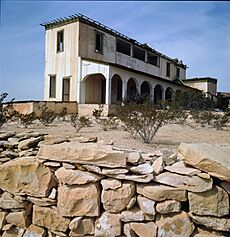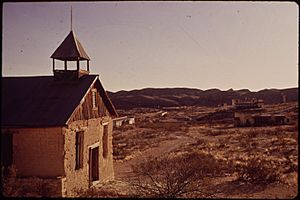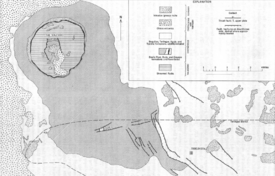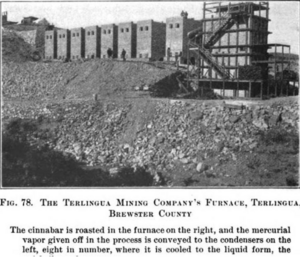Terlingua, Texas facts for kids
Quick facts for kids
Terlingua, Texas
|
|
|---|---|
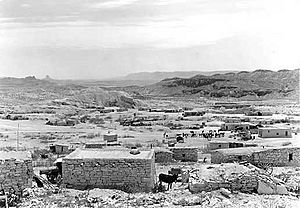
Terlingua in 1936
|
|
| Nickname(s):
Terlingua Ghost Town
|
|
| Motto(s):
"The Texas Ghost Town"
|
|
 |
|
| Country | United States |
| State | Texas |
| County | Brewster |
| Area | |
| • Total | 11.0 sq mi (28.5 km2) |
| • Land | 11.0 sq mi (28.5 km2) |
| • Water | 0 sq mi (0.0 km2) |
| Elevation | 2,507 ft (764 m) |
| Population
(2020)
|
|
| • Total | 78 |
| • Density | 7.09/sq mi (2.737/km2) |
| Time zone | UTC-6 (Central (CST)) |
| • Summer (DST) | UTC-5 (CDT) |
| FIPS code | 48-72248 |
| GNIS feature ID | 2584745 |
Terlingua is a small mining area and town in southwestern Brewster County, Texas, United States. It is close to the Rio Grande river and the towns of Lajitas and Study Butte, Texas. It is also near the Mexican state of Chihuahua.
In the mid-1880s, a mineral called cinnabar was found here. This mineral is used to get the metal mercury. The discovery of cinnabar brought many miners to the area, and the town grew to 2,000 people. Today, what's left of the mining days is a ghost town. It includes parts of the Chisos Mining Company, once owned by Howard Perry. There are also several old, closed mines nearby. The mineral terlinguaite was first discovered in this area.
In 2020, the population of Terlingua was 78 people.
Contents
History of Terlingua Mining
It's hard to know exactly when cinnabar was first found in Terlingua. Stories about its discovery are mixed with legends. Native Americans likely knew about cinnabar. They might have used its bright red color for pictographs, which are ancient rock paintings.
Early Discoveries and Growth
A man named Jack Dawson is said to have produced the first mercury from Terlingua in 1888. However, the mining in the area started slowly. News about the Terlingua finds didn't become widely known until the mid-1890s. By 1900, four mining companies had already produced a lot of mercury. These companies included Lindheim and Dewees, Marfa and Mariposa, the California, and the Excelsior.
By 1903, more companies joined them. These were the Texas Almaden Mining Company, the Big Bend Cinnabar Mining Company, and the Colquitt-Tigner combine.
How Terlingua Got Its Name
George W. Wanless and Charles Allen started working in the California Mountain area around 1894. They heard reports from Mexican miners who had been there since 1850. Ore was found in 1896. Other miners like Jack Dawson, J.A. Davies, and Louis Lindheim soon followed.
A post office was set up in Terlingua in 1899. It was located in the California Mountain mining community. The name Terlingua might come from "Tres Lenguas" in Spanish, meaning "three tongues." This could refer to an early mine or a local landmark. By 1903, about 3,000 people lived in the area. The main mining center and post office later moved to the Chisos Mine area. The original settlement then became known as Mariposa.
Howard E. Perry and the Chisos Mine
Howard E. Perry was born in Cleveland, Ohio, in 1858. He worked for his father's lumber company. In 1881, he moved to Chicago and started working at C.M. Henderson. He became a director there after marrying Grace Henderson in 1897. Later, in 1914, they moved to Portland, Maine.
Starting the Chisos Mining Company
By 1887, Perry owned some land in Texas. He likely got it as payment for an old debt. People offered him more and more money for his property. This made him curious, so he hired a lawyer to investigate. The lawyer found that mining on nearby land was actually happening on Perry's property due to a mistake in an old survey.
Perry's lawyers took action in 1900, and he won the case in 1901. He officially gained control of the land. On May 8, 1903, Perry started the Chisos Mining Company. He got a $50,000 loan to begin. The company reported its first mercury production that same year.
Growing the Mining Operation
In 1904, the company added more equipment and produced 200 flasks of mercury each month. In 1905, they leased a large furnace from another company. That same year, Perry hired Dr. William Battle Phillips, an expert who taught Perry about mining. In 1906, they decided to install an even bigger furnace.
At first, the furnace was heated with local wood. But in 1926, Perry hired a geologist to look for coal on his land. The coal found was then used to make gas for heating. Water was brought in by Mexican transporters from the Rio Grande, 12 miles away. Some water also came from a dam on Terlingua Creek. Water was also hauled from springs found in the Christmas Mountains. By the mid-1920s, water was pumped from deep inside the Chisos mine itself.
Perry's Management Style
When Dr. Phillips left in 1906, Perry started managing the mine directly. What was unusual was that he did all this from his office in Chicago. He was known for managing the mine from far away, paying close attention to every detail. He received reports on production by telegraph twice a week. These reports and other messages used secret codes to keep information private.
In 1906, Perry built his impressive Perry Mansion. It was inspired by the buildings he saw during a visit to Almadén. This two-story house had nine bedrooms, a wine cellar, and a long front porch. By 1913, Perry had also built the Chisos Hotel, a company store, an ice-making plant, and provided telephone service in Terlingua. Mail was delivered three times a week. By 1936, he added the Chisos Theatre and a candy shop. His miners, mostly Mexican, lived in company homes without paying rent.
Perry loved yachts and owned several large ones. He believed that wanting these expensive boats pushed him to make more money. Because of his control, Terlingua became known as the "Land of Perry." He managed almost every part of life there.
Challenges and Decline
By 1930, the good times for the mine started to end. Perry had to pay a large sum of money to a nearby mine because his mine had dug into their land. In 1934, he had to increase miners' wages. There were also concerns that the mine was unsafe for workers. One geologist said the mine was "extremely hot" and lacked proper air circulation.
Perry's financial problems grew when he bought other mines. Even though a new ore deposit was found in one of them, by 1939, it was reported that the Chisos Mine was "worked out." Perry also spent money on other mines that didn't do well. With more debts and angry creditors, Perry's company went bankrupt on October 1, 1942. Perry himself passed away not long after, in 1944.
Geology and Mining Operations
The Terlingua area has unique geology. The main mineral found here is cinnabar, which is used to get mercury. It is often found in cracks in igneous rocks, which are formed from cooled lava. The best deposits are usually found where two types of rock meet: limestone and clay formations. The most valuable deposit was in the Chisos Mine.
The Chisos Mine
The Chisos Mine was located right in Terlingua. It was the biggest producer of mercury in the area. Discovered in 1902, it operated until 1943. It produced 100,000 flasks of mercury. The mine had three main shafts and 23 miles of tunnels across 17 levels. It also had a large furnace and a rotary furnace for processing the ore. The mine was operated by Howard E. Perry's Chisos Mining Co. until 1942. It was then bought by another company, which closed it after World War II. The town was abandoned, and all company buildings were taken apart. At its busiest, the mine employed 125 men working around the clock.
Other Important Mines
The Mariposa Mine was the second-largest producer of mercury. It was located seven miles west of Terlingua. It operated from 1901 to 1910 and again during World War II. Most of its mercury came from caves found in the limestone.
The Study Butte Mine was the third-largest producer, located five miles east of Terlingua. Cinnabar was found here in 1902, and mining started in 1905. This mine had four main shafts and two furnaces. It closed when water flooded the mine tunnels.
The Terlingua district produced most of the quicksilver (mercury) in the U.S. until at least 1937. However, mercury prices dropped, causing all the mines to close by 1947.
Population Changes
| Historical population | |||
|---|---|---|---|
| Census | Pop. | %± | |
| 2020 | 78 | — | |
| U.S. Decennial Census 1850–1900 1910 1920 1930 1940 1950 1960 1970 1980 1990 2000 2010 |
|||
Culture and Tourism
Today, Terlingua is mostly a place for tourists. Many visitors come because it is close to Big Bend National Park. People enjoy outdoor activities like:
- Rafting and canoeing on the Rio Grande
- Mountain biking
- Camping
- Hiking
- Motorcycling
Chili Cook-Offs
Every year, on the first Saturday of November, over 10,000 "chiliheads" gather in Terlingua. They come for two big annual chili cookoffs. These are the Chili Appreciation Society International cook-off and the Frank X. Tolbert/Wick Fowler World Chili Championship, which started in 1967. One of the founders of the first chili cook-off was car manufacturer Carroll Shelby, who owned a large ranch nearby.
Terlingua Cemetery
Near the general store is the Terlingua Cemetery. The oldest grave there dates back to 1903, when the cinnabar mining began. People who live in Terlingua still use the cemetery today. Every year, they celebrate Dia de los Muertos there.
Terlingua in Media
Terlingua has been featured in movies and TV shows:
- It appears in Wim Wenders' movie Paris, Texas.
- It was the main focus of the 2015 National Geographic Channel show Badlands, Texas.
- It was the main filming location for the 1993 Kenny Rogers TV movie Rio Diablo.
Education in Terlingua
Education in Terlingua began in the 1909–1910 school year in a "tent-house." By 1923, the school had 53 students taught in one adobe classroom. Four teachers joined the staff by the 1927–1928 school year. In 1930, the Chisos Mining Company built the Perry School. This was a four-room building for the 141 students enrolled in the 1931–1932 school year.
Today, Terlingua is served by the Terlingua Common School District. Big Bend High School is the local high school. Before 1996, high school students went to Alpine High School. The Terlingua Common School District used to have Big Bend High and Terlingua Elementary as separate schools.
For community college, Brewster County is part of the Odessa College District.
Climate
Terlingua has a lot of sunshine throughout the year. This is because of stable air and high pressure in the area. The climate is similar to that of nearby Presidio.
See also
 In Spanish: Terlingua (Texas) para niños
In Spanish: Terlingua (Texas) para niños


